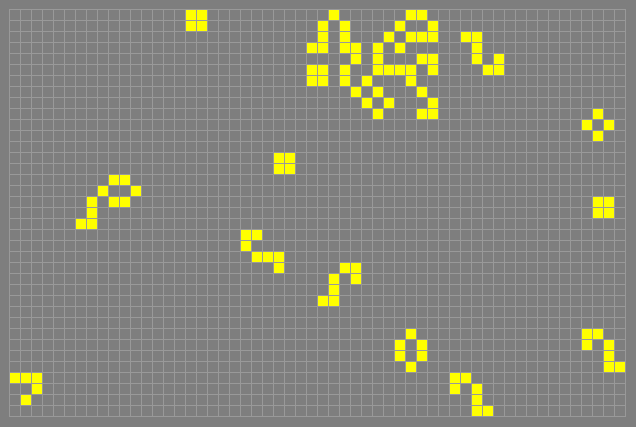Any stable or oscillating pattern that can reflect some
type of spaceship (usually a glider) without suffering permanent
damage. A pattern that is damaged or destroyed during the reflection
process is generally called a one-time turner instead.
The first known reflector was the pentadecathlon, which functions
as a 180-degree glider reflector (see relay). Other examples
include the buckaroo, the twin bees shuttle and some oscillators
based on the traffic jam reaction. Glider guns can also be made
into reflectors, although these are mostly rather large.
In September 1998 Noam Elkies found some fast small-period glider
reflectors, with oscillators supplying the required domino
sparks at different periods. A figure-8 produced a p8 bouncer,
and a p6 pipsquirter produced an equivalent p6 bouncer. A more
complicated construction allows a p5 bouncer (which, as had been
anticipated, soon led to a true p55 Quetzal gun). And in August
1999 Elkies found a suitable sparker to produce a p7 bouncer,
allowing the first p49 oscillator to be constructed.
These were all called simply "p5 reflector", "p6 reflector", etc.,
until 6 April 2016 when Tanner Jacobi discovered an equally small and
simple reaction, the bumper, starting with a loaf as bait
instead of a boat. This resulted in a series of periodic
colour-preserving reflectors, whereas Elkies' bouncer reflectors
are all colour-changing. A useful mnemonic is that "bouncer"
contains a C and is colour-changing, whereas "bumper" contains a P
and is colour-preserving.
Stable reflectors are special in that if they satisfy certain
conditions they can be used to construct oscillators of all
sufficiently large periods. It was known for some time that stable
reflectors were possible (see universal constructor), but no one
was able to construct an explicit example until Paul Callahan did so
in October 1996.
Callahan's original reflector has a repeat time of 4840, soon
improved to 1686, then 894, and then 850. In November 1996 Dean
Hickerson found a variant in which this is reduced to 747. Dave
Buckingham reduced it to 672 in May 1997 using a somewhat different
method, and in October 1997 Stephen Silver reduced it to 623 by a
method closer to the original. In November 1998 Callahan reduced
this to 575 with a new initial reaction. A small modification by
Silver a few days later brought this down to 497.
In April 2001 Dave Greene found a 180-degree stable reflector with
a repeat time of only 202 (see boojum reflector). This reflector
won bounties offered by Dieter Leithner and Alan Hensel. Half of the
prize money was recycled into a new prize for a small 90-degree
reflector, which in turn was won by Mike Playle's colour-preserving
Snark reflector. The Snark is currently the smallest known stable
reflector, with a recovery time of 43. Playle has offered a $100
prize for a colour-changing stable reflector contained within a 25
by 25 bounding box, with a recovery time of 50 generations or less.
As of June 2018, the following splitter is among the smallest
known 90-degree colour-changing reflectors. The top output can
be blocked off by an eater if needed. For small 180-degree
colour-changing reflectors see rectifier, and also the sample
pattern in splitter.










